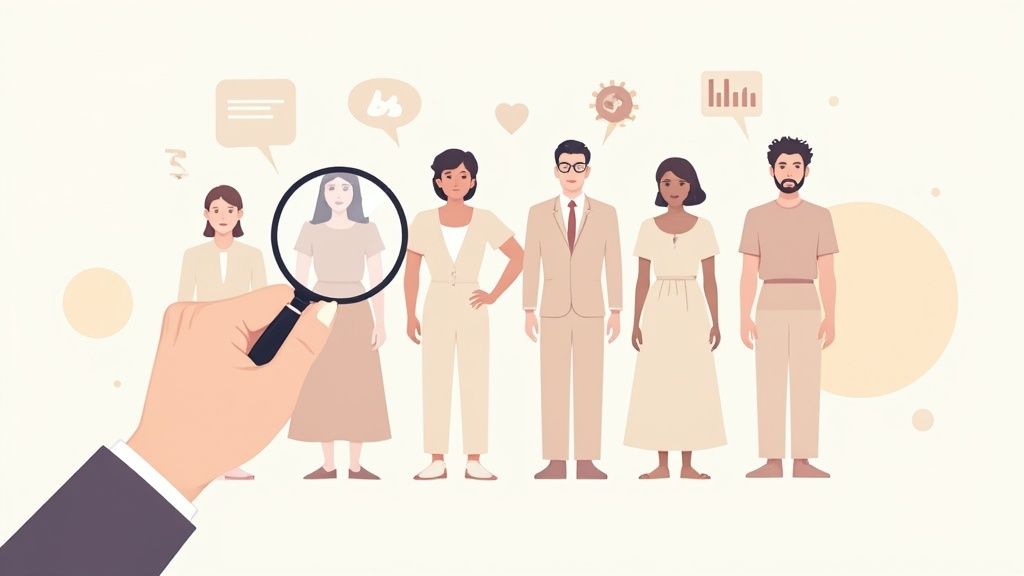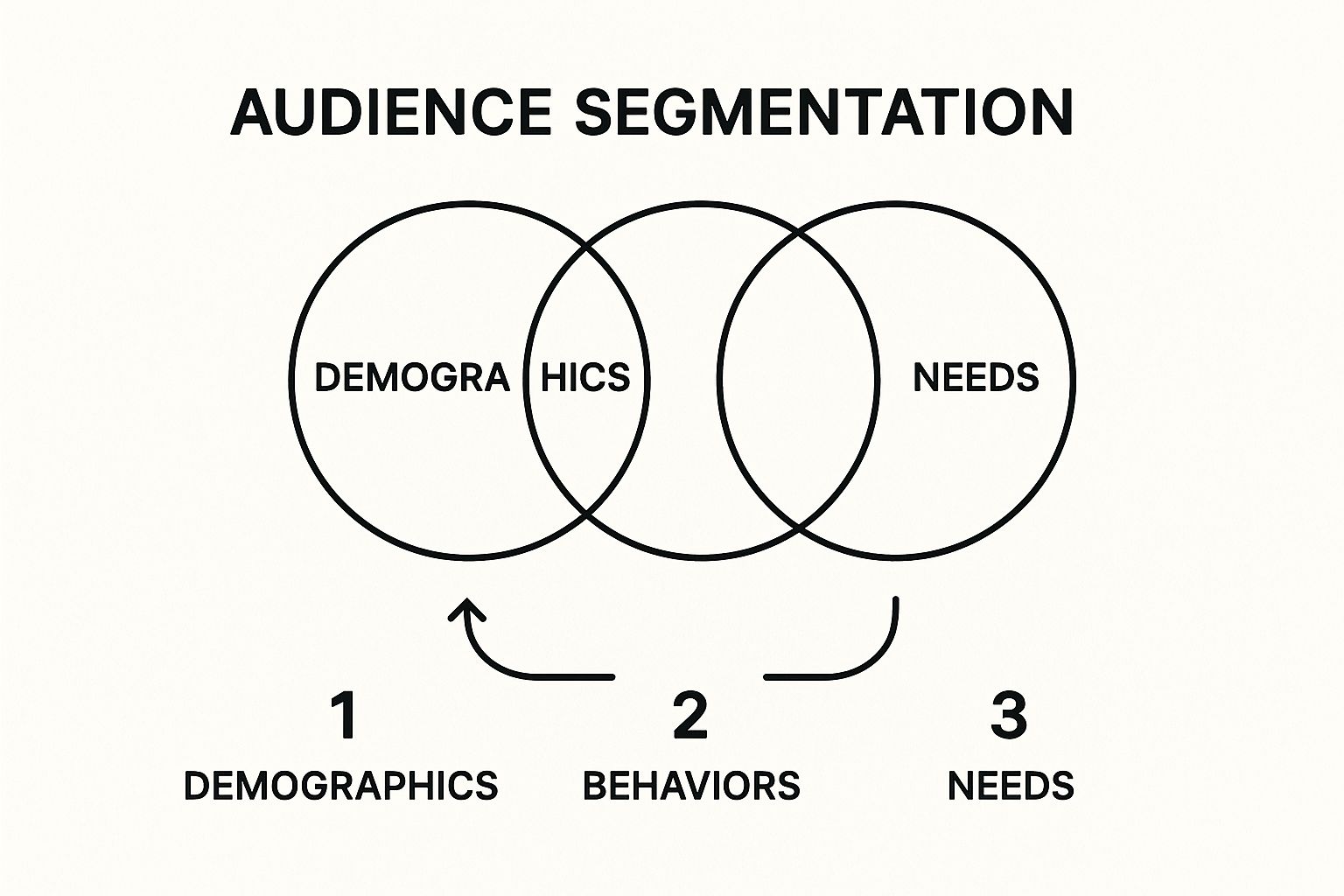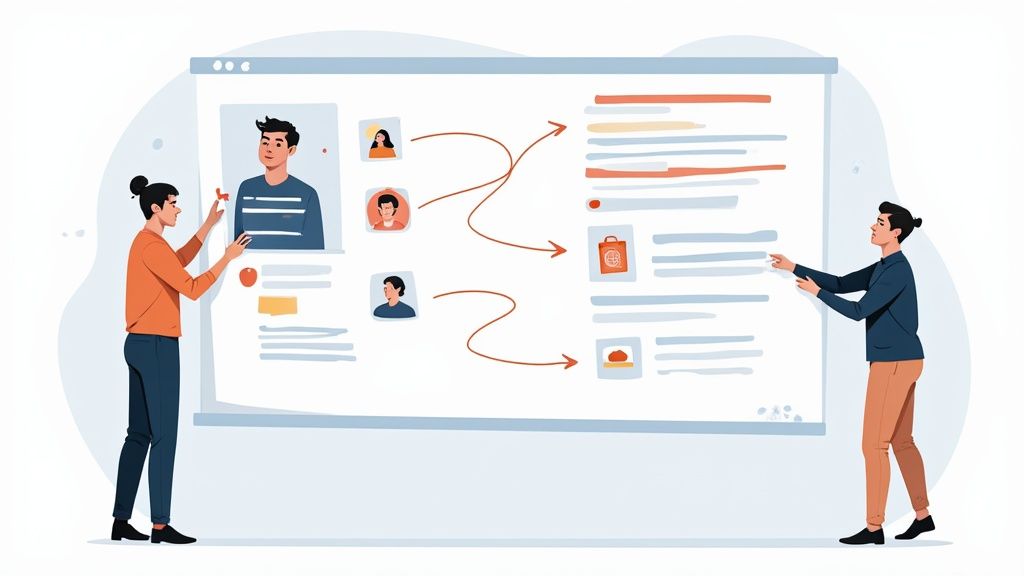How to Create Buyer Personas That Drive Growth

Creating a solid buyer persona isn't some mystical marketing art. It’s a straightforward process: you research your audience, hunt for patterns in the data, and then build out detailed profiles that feel like real people. This is how you turn cold, hard data into relatable human stories that can steer your entire marketing strategy.
Moving Beyond One-Size-Fits-All Marketing
Let's be real for a second: generic marketing is a colossal waste of time and money. Blasting a single, bland message to a massive audience just doesn't work anymore. The brands winning today are the ones obsessed with their customers. They've ditched vague assumptions for specific, empathetic insights about the people they're trying to reach.
This is where knowing how to create buyer personas becomes your secret weapon.
A lot of people think a persona is just a made-up character. That's a huge misconception. A real persona is a research-backed profile that represents an actual segment of your audience. Building one is your first move away from shouting at everyone and toward having meaningful conversations with the right people. The result? Better engagement, higher-quality leads, and growth that actually lasts.
Why Data-Backed Personas Always Win
The impact of getting this right isn't just a "nice-to-have" feeling; the numbers back it up. Companies that actually create and use detailed personas consistently run circles around their competition. The data shows a crystal-clear line between understanding your customer and hitting your business goals.
Over 60% of companies that have updated their buyer personas within the last six months have blown past their lead generation and revenue goals.
And it gets better. Being a truly customer-centric organization—one that has personas woven into its DNA—is a direct route to being more profitable. Research from Deloitte shows these organizations are often 60% more profitable than their less customer-focused peers. That's the undeniable power of deep audience understanding. You can dig into more persona statistics to see the full picture of their impact.
The Foundation of a Smarter Strategy
At the end of the day, the goal is to create a framework that gets your whole team on the same page. When marketing, sales, and product development all share the exact same picture of "who" the customer is, everything clicks into place. Your efforts become aligned and way more effective.
A well-crafted persona is a constant gut-check, a reminder of the human on the other side of the screen. It ensures every single decision—from a blog post topic to a new feature—is made with their needs, challenges, and goals front and center. It's the bedrock of a strategy that doesn’t just get attention, but builds real, lasting loyalty.
Digging for Gold in Your Customer Data
Great personas aren't just dreamed up in a boardroom; they're built on a foundation of solid evidence. This is where you put on your detective hat and start digging into the data you already have. You’re looking for the real stories, the human truths hidden behind the numbers. It’s all about blending the "what" with the "why."
Quantitative data gives you the hard numbers—the facts about who your customers are and how they act. But it's the qualitative data that adds the color, the context, and the rich human details that numbers alone can't provide. The best personas come from marrying the two.
This data-first approach makes your personas incredibly reliable because they're based on actual customer behavior, not just a hunch. We're talking about everything from basic demographics to social media habits.
Start With the Quantitative Clues
Your first stop should be your own backyard. You're probably sitting on a goldmine of data in tools like your CRM and Google Analytics. Don't just skim the dashboard; it’s time to really explore the reports that show you what people are doing.
- Google Analytics: Dive into the Demographics and Interests reports. Where are your visitors coming from? What's their age and gender? Which pages are they glued to?
- CRM Data: Pull up your customer database and look for patterns. Do your best customers share common job titles or company sizes? Is there a trend in how they found you or what they bought first?
- Social Media Insights: Platforms like LinkedIn and Instagram offer surprisingly detailed analytics on your followers. This data can tell you about their industries, their interests, and what kind of content makes them stop scrolling.
For instance, a quick look at your Google Analytics might show you which countries are bringing in the most traffic.

This one simple chart already tells you where your audience is concentrated, giving you a huge head start on tailoring your content and ad campaigns.
Now, Gather the Qualitative Stories
Numbers give you the outline, but conversations fill in the details. This is how you uncover your customers' real motivations, their biggest headaches, and their ultimate goals. To make sure your personas are grounded in reality, you need to master effective customer feedback collection methods that pull out genuinely useful insights.
Pro Tip: When you're talking to customers, fight the urge to ask leading questions. Instead of, "Was our onboarding easy?" try, "Can you walk me through how you got started with our product?" Open-ended questions like that invite much more honest and detailed stories.
Don't forget about the experts you have in-house. Your internal teams are another incredible source of qualitative insight.
Talk to your sales team. They’re on the front lines every single day. Ask them what objections they hear all the time, what the big "aha!" moments are for new prospects, and the exact words customers use to describe their problems.
Interview your customer support reps. These folks know your customers' pain points better than anyone. They can tell you where people get stuck, which features they absolutely love, and what drives them crazy. This is a non-negotiable part of any solid https://www.lumeo.me/en/blog/target-audience-analysis.
When you bring all of these data sources together, you create personas that aren't just abstract profiles. They become living, breathing representations of who your customers are and what they actually need from you.
Building Your Persona From Raw Research
Once you’ve gathered all that rich customer data, it can feel like you're staring at a giant, messy puzzle. You have piles of survey results, interview notes, and analytics reports. So, what’s next? The real work begins now: turning that mountain of raw information into a coherent, actionable buyer persona.
This is where you switch gears from data collection to data synthesis. Your mission is to hunt for the recurring themes and common threads that tie a specific group of your customers together. Start sifting through everything. Did several interviewees mention the exact same daily frustration? Do you see a particular demographic consistently using a specific feature in your product?
These patterns are the very building blocks of your persona.
Identifying Meaningful Segments
You'll quickly realize your audience isn't one monolithic group. They naturally cluster into different segments based on their unique goals, challenges, and behaviors. The trick is to pinpoint the most meaningful segments—the ones that represent your most valuable customers.
This is where you look for the overlap between different data points to really crystallize an audience segment.

As you can see, the sweet spot for a strong persona is right where demographics, behaviors, and needs intersect. A persona isn't just about one of these areas; it’s about the complete story they tell together. Effectively mapping this out is a huge part of the process, and knowing some data visualization best practices can make your findings much clearer for the rest of your team.
For instance, you might uncover a segment of "Marketing Managers at Mid-Sized Tech Companies" (Demographics) who "Struggle with Reporting ROI" (Needs) and "Consistently Read Industry Blogs for Solutions" (Behaviors). That’s a powerful, specific segment you can build a fantastic persona around.
Crafting the Persona Profile
Now for the fun part: bringing these segments to life. A persona profile is far more than a dry list of facts; it’s a narrative designed to help your entire team develop genuine empathy for the customer. Give your persona a name, a job title, and even a stock photo to make them feel like a real person you're all working to help.
A great persona document should feel like a character sheet for a real person. It should be concise, memorable, and instantly understandable to anyone in the company, from a new sales hire to the CEO.
Start by outlining the key components of their story. A simple but incredibly effective template includes dedicated sections for their background, goals, and challenges.
Key Profile Sections to Include:
- Background & Demographics: Lay the groundwork. What's their job title, industry, and company size? What about their age and education? This sets the stage.
- Goals: What are they trying to achieve in their role? Think about what success looks like for them, both personally and professionally.
- Challenges: What are the biggest obstacles standing in their way? What are the pain points that keep them up at night?
- How We Help: This is the most crucial part. Clearly connect the dots and articulate exactly how your product or service helps them smash their challenges and hit their goals.
By filling out these details, you transform a jumble of data points into a relatable human story. This profile becomes the guiding star for your content, product, and sales strategies, making sure everyone is aligned on who you're helping and why it matters.
Putting Your Personas to Work Across the Business
So, you’ve done the research and built out a set of detailed buyer personas. That’s a huge win, but the job’s not done. The real value of a persona isn’t in the document itself—it’s in how you use it. If it just collects digital dust in a shared folder, you’ve wasted your time.
The payoff comes when your personas become the common language everyone in the company uses to talk about the customer. Think of them as a shared lens. When every single team—from marketing to product to support—sees the customer through that same lens, alignment just clicks into place. It’s how you start breaking down those departmental silos for good.
Driving Smarter Marketing and Sales Efforts
For marketers, this is where personas feel like a cheat code. All the guesswork about what topics will land or what messaging will resonate? Gone. Instead, you can build a content strategy that speaks directly to the specific goals and pain points you know your audience has.
This clarity should trickle down into everything you do:
- Ad Campaign Targeting: Stop wasting money on broad audiences. Use your persona’s demographics and interests to build laser-focused audiences for your paid social and search campaigns.
- Email Marketing: Segment your lists by persona. Now you can send newsletters and nurture sequences that feel like they were written just for that one person, which is how you get those open and engagement rates to climb.
- Content Creation: Every webinar, Instagram post, or white paper should be created with a primary persona in mind. This is a non-negotiable part of any solid B2B content marketing strategy because it guarantees relevance.
Over on the sales side, personas are a secret weapon for building rapport and navigating objections. Imagine a sales rep jumping on a call already understanding the prospect's deep-seated motivations. They can skip the generic pitch and focus on the solutions that actually matter, making the whole conversation feel less like a sale and more like a consultation.
Guiding Product Development and Customer Experience
The impact of personas shouldn't stop with marketing and sales. Your product and support teams need them just as much. Personas provide the why behind the what, giving them the context to build products people genuinely want to use.
It's a game-changer when your product team isn't just building a "reporting feature." Instead, they know they're building it for "Marketing Manager Maria," who is tearing her hair out trying to prove ROI to her boss. Suddenly, their decisions are sharper, more focused, and infinitely more impactful.
This isn't just theory; it has a real financial impact. One fintech app, for instance, used deep-dive surveys to craft digital buyer personas that guided everything from their marketing copy to their pricing structure. The result? This persona-driven approach led to a forecasted 29% jump in revenue and a 15% increase in new customer acquisition.
This customer-first mindset naturally flows to your support team. When an agent understands the persona of the user they're helping, they can offer more empathetic, effective support. They know the user's goals and common frustrations, which lets them solve the immediate problem while also anticipating what they might need next.
When you put your buyer personas to work, you’re doing more than just improving tactics. You're aligning the entire company around the one thing that truly matters: the customer.
Avoiding Common Buyer Persona Mistakes
You’ve done the work and built your buyer personas. That’s a massive step forward, but here’s where many well-intentioned teams go wrong. They create these beautiful, detailed profiles... and then they just sit there, gathering digital dust.
Let’s talk about the common traps that turn a powerful strategic tool into a forgotten file. We'll make sure that doesn't happen to you.

One of the biggest pitfalls I see is creating way too many personas. It's easy to get carried away and end up with ten different profiles, each representing a tiny sliver of your audience. This "persona-palooza" leads to total paralysis. When you try to create content for everyone, you end up connecting with no one.
The whole point of a buyer persona is focus, not creating a comprehensive catalog of every possible customer. Stick to just 3 to 4 key personas. These should represent the most valuable and significant segments of your audience. This forces you to prioritize and put your resources where they’ll actually make a difference.
Another classic misstep is leaning on stereotypes instead of solid data. Crafting a persona based on a gut feeling is just a fancy way of guessing, and it's a recipe for disaster. This is how you end up with generic, useless profiles like "Startup Steve" or "Millennial Molly" that are too vague to guide any real strategy.
Keeping Your Personas Relevant and Actionable
Here's the thing: even the most data-driven personas have a shelf life. Markets change, customer needs evolve, and your own product line gets updated. A persona you built two years ago probably doesn't reflect your ideal customer today. Treating them as a one-and-done project is a huge mistake.
So, how do you keep them fresh and useful? Schedule a refresh.
It doesn’t have to be complicated. Here's a simple rhythm to follow:
- Annual Review: At the very least, pull your personas out once a year. Get marketing, sales, and product in a room (or a video call) to talk about what's changed and what's still true.
- Trigger-Based Updates: Don't just wait for the calendar. If something big happens—a major product launch, entering a new market, or a weird dip in marketing performance—that’s your cue to re-evaluate your personas right away.
- Ongoing Feedback Loop: Your sales and support teams are on the front lines. Empower them to share what they're hearing. A quick note in a shared doc about a new, recurring customer question can be the spark that leads to a critical persona update.
Finally, a persona is completely useless if no one can find it. Don't bury these documents in a labyrinth of folders. Make them visible. Pin them in your team's Slack channel, make them part of new employee onboarding, and bring them up constantly in strategy meetings.
When you keep your personas top-of-mind, you ensure your investment in understanding your audience pays off for years to come.
Your Questions on Buyer Personas Answered
As you start digging into buyer personas, a few questions always pop up. It's totally normal. Getting everyone on the same page with clear answers from the get-go is key to keeping the project moving forward.
Let's tackle the big ones I hear all the time.
How Many Buyer Personas Should We Create?
This is always the first question, and my answer is almost always the same: fewer than you think.
It's tempting to create a unique persona for every little customer variation you can think of. But trust me, that path leads to a pile of profiles nobody uses and a whole lot of confusion.
For most businesses, 3 to 5 core personas is the sweet spot. It’s a manageable number that forces you to zero in on the audience segments that actually move the needle. Focus on the groups that bring in the most revenue or represent your biggest opportunities for growth.
You can always build more later on as your business grows. Starting small keeps your marketing sharp and focused.
Is a Buyer Persona the Same as a Target Market?
Nope, but they are related. It's a common point of confusion.
Think of it this way: a target market is the wide-angle shot, while a buyer persona is the close-up portrait.
- Target Market: This is your broad overview. For example, "small business owners in the U.S. technology sector."
- Buyer Persona: This gets specific and personal. For example, "‘Tech-Savvy Tina,’ a 38-year-old founder of a 15-person SaaS startup who is struggling to scale her marketing efforts."
The target market tells you what group of people you're aiming for. The persona gives that group a face, a name, and a story. This is what helps your team truly understand their goals, their headaches, and their motivations on a much deeper level.
A persona turns abstract data into a relatable character. This shift is what enables your team to move from generic messaging to creating content that truly resonates with an individual's specific needs and challenges.
How Often Should We Update Our Personas?
Creating personas isn't a "one and done" project. Your customers change, markets shift, and your own products evolve. A persona you built two years ago is probably out of date.
At a minimum, you should plan to give your personas a full review and refresh at least once a year.
But you also need to treat major business events as a trigger for an immediate check-in. This could be anything from launching a new product line to entering a new market, or even just noticing that your marketing campaigns aren't hitting like they used to.
These are all signals that your customers' world has changed, and your personas need to change with it.
Ready to turn your best content into visually stunning carousels that capture attention? With Lumeo, you can transform articles, videos, and even tweets into engaging visual stories perfect for LinkedIn and Instagram. Start creating for free and see the difference.